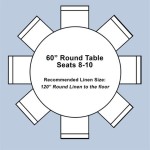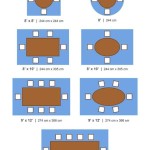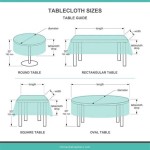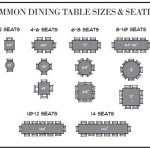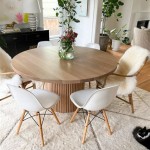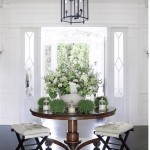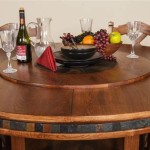How to Measure for an Oblong Tablecloth
Selecting the right tablecloth can significantly enhance the aesthetic appeal of a dining or accent table. An oblong, or rectangular, tablecloth is a common choice, offering a versatile and elegant covering for various table sizes and shapes. However, accurately measuring the table is crucial to ensure the tablecloth hangs properly and complements the space. This article provides a comprehensive guide on how to measure for an oblong tablecloth, focusing on practical steps and considerations to achieve the desired look and functionality.
The primary goal when measuring for an oblong tablecloth is to determine the appropriate size that adequately covers the table while providing the desired overhang. Overhang refers to the portion of the tablecloth that drapes over the edges of the table. The ideal overhang is a matter of personal preference and can vary depending on the formality of the occasion and the overall style of the room. A too-short tablecloth may look inadequate, while an excessively long one can be impractical and visually overwhelming.
Understanding the Importance of Overhang
The overhang is a critical element in determining the final dimensions of the tablecloth. It not only contributes to the aesthetic appeal but also provides practical benefits. A well-chosen overhang protects the table edges from spills and scratches and adds a sense of elegance to the dining experience.
For casual settings, a shorter overhang, typically ranging from 6 to 10 inches, is often preferred. This provides a relaxed and informal look, suitable for everyday use. A shorter overhang is also less likely to interfere with chairs or create tripping hazards. In more formal settings, a longer overhang, usually between 10 and 15 inches, is considered more appropriate. This creates a more luxurious and sophisticated ambiance, ideal for special occasions and dinner parties. Floor-length tablecloths, where the overhang reaches the floor, are generally reserved for very formal events or decorative accent tables.
Consideration should also be given to the height of chairs surrounding the table. If chairs are low to the ground, a longer overhang might impede movement and comfort. Conversely, taller chairs might require a slightly longer overhang to maintain visual balance. Accessibility for seated guests is paramount; the tablecloth should not hinder their ability to comfortably sit and move around the table.
Step-by-Step Guide to Measuring Your Oblong Table
Accurate measurement is the foundation for selecting the correct tablecloth size. The following steps provide a clear and concise method for measuring an oblong table:
- Gather Your Tools: You will need a measuring tape (preferably a flexible cloth or fiberglass tape), a pen or pencil, and a piece of paper to record your measurements. Avoid using metal measuring tapes as they can be less flexible and potentially scratch the table surface.
- Measure the Length: Place the measuring tape along one of the longer sides of the table, from one end to the other. Ensure the tape is straight and taut, avoiding any sagging. Record this measurement in inches or centimeters, depending on your preferred unit.
- Measure the Width: Measure the shorter side of the table, again placing the measuring tape from one end to the other. Ensure the tape is straight and taut. Record this measurement as well.
- Determine Desired Overhang: Decide on the desired overhang length based on the formality of the occasion and personal preference. As mentioned earlier, a shorter overhang (6-10 inches) is suitable for casual settings, while a longer overhang (10-15 inches) is appropriate for formal events.
- Calculate the Tablecloth Length: To calculate the required tablecloth length, add twice the desired overhang to the table length. For example, if the table length is 60 inches and the desired overhang is 10 inches, the tablecloth length should be 60 + (2 * 10) = 80 inches.
- Calculate the Tablecloth Width: Similarly, to calculate the required tablecloth width, add twice the desired overhang to the table width. For example, if the table width is 36 inches and the desired overhang is 10 inches, the tablecloth width should be 36 + (2 * 10) = 56 inches.
- Record the Final Measurements: Clearly record the final length and width measurements of the tablecloth. These measurements will be crucial when searching for and purchasing the appropriate tablecloth.
It is always advisable to double-check your measurements to minimize the risk of errors. If you are unsure about any step, consider asking a friend or family member to assist you in measuring the table.
Factors to Consider When Choosing a Tablecloth Size
Beyond the basic measurements, several other factors can influence the optimal tablecloth size. Understanding these considerations will help you make a more informed decision and ensure the tablecloth perfectly complements your table and dining space.
Table Shape Irregularities: While most oblong tables are perfectly rectangular, some may have slightly rounded corners or other minor shape irregularities. In such cases, it is best to measure the table at its widest and longest points to ensure the tablecloth provides adequate coverage. If the corners are significantly rounded, consider using a tablecloth with rounded corners or opting for a larger size to accommodate the curves.
Table Height: The height of the table can also influence the perceived length of the overhang. A taller table will require a longer overhang to achieve the desired visual effect, while a shorter table may benefit from a shorter overhang. Consider the table's height relative to the seating and surrounding furniture when determining the overhang length.
Fabric Shrinkage: Different fabrics have varying degrees of shrinkage when washed. Natural fabrics like cotton and linen are particularly prone to shrinkage. To account for this, it is recommended to add an extra inch or two to the calculated tablecloth length and width. This will help ensure the tablecloth maintains its desired size even after washing. Always refer to the manufacturer's care instructions to determine the expected shrinkage rate for the specific fabric.
Hem Allowance: The hem of the tablecloth can also subtly affect the overall size. A wider hem will shorten the effective length and width of the tablecloth slightly. If the tablecloth has a particularly wide hem, consider adding an extra half-inch to the calculated measurements to compensate.
Availability of Sizes: Tablecloths are typically available in standard sizes. It may not always be possible to find a tablecloth that perfectly matches your calculated measurements. In such cases, it is generally better to choose a slightly larger tablecloth rather than a smaller one. A larger tablecloth can always be adjusted or hemmed if necessary, while a smaller tablecloth will not provide adequate coverage. Consider the standard sizes available from different retailers and choose the closest option that meets your needs.
Layering Tablecloths: Layering tablecloths can add depth and visual interest to your table setting. If you plan to layer tablecloths, be sure to consider the size and overhang of each layer. The top tablecloth should typically be smaller than the bottom tablecloth, allowing the bottom layer to peek through and create a layered effect. When measuring for layered tablecloths, consider the desired overhang for each layer and calculate the appropriate sizes accordingly.
Special Occasions: The formality of the occasion should also influence your choice of tablecloth size. For formal events like weddings or banquets, a longer overhang and more luxurious fabric are generally preferred. For casual gatherings, a shorter overhang and more durable fabric are often more appropriate. Consider the overall ambiance you wish to create and choose a tablecloth size and fabric that aligns with the occasion.
By carefully considering these factors in addition to the basic measurements, you can ensure that the tablecloth you choose is not only the correct size but also perfectly complements your table and dining space. The effort invested in accurate measurement and thoughtful consideration will result in a beautifully dressed table that enhances the overall aesthetic appeal of your home.

Tablecloth Size Calculator Find The Right

What Size Tablecloth Do I Need Deconovo Us

How To Choose Tablecloths Understanding Correct Measurements Your Chair Covers Inc

Tablecloth Size Calculator Find The Right

How To Choose The Correct Size Tablecloth For Your Table

How To Choose The Correct Size Tablecloth For Your Table

Tablecloth Size And How To Choose The Right One

How To Measure Luxury Tablecloths

3 Easy Ways To Measure Tablecloth Sizes Your Table Linens Size Guide
Related Posts

